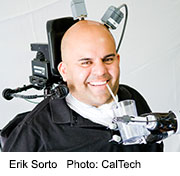Research is still preliminary, but implants demonstrating some success
FRIDAY, May 22, 2015 (HealthDay News) — Researchers have steadily been making progress in developing mind-controlled robotic limbs. One patient’s case is reported in the May 22 issue of Science.
The patient has two tiny chips implanted in the posterior parietal cortex (PPC), which controls the intention to move. That’s in contrast to the handful of other paralyzed individuals who’ve been given similar implants. But in those cases, the chips have been placed in the brain’s motor cortex, which is involved in the direct execution of movement. It’s a key distinction, explained senior researcher Richard Andersen, Ph.D., a professor of neuroscience at the California Institute of Technology in Pasadena.
Signals sent from the brain’s motor cortex are involved in the details of movement — like “lift the arm” and “extend the arm.” Signals from the PPC are “higher level,” and related to overall goals, such as “I want to pick up that cup.” So devices implanted in the PPC could make it easier for people to control a robotic arm with their thoughts, and make those movements more fluid and natural, Andersen told HealthDay. He said two additional patients have since had chips implanted in the PPC, and a few patients at other research centers have had similar devices implanted.
For now, the robotic arms are confined to the lab setting. After surgery, patients are left with terminals protruding from the skull that are used to connect the implanted chips to a computer system that decodes the signals being sent from the brain — such as, “I want to pick up that cup.” That message sparks the robotic arm to move. For the approach to work in real life, the technology will have to go wireless, Andrew Pruszynski, Ph.D., the author of an editorial published with the study, and an assistant professor at Western University in London, Canada, told HealthDay.
Abstract
Full Text (subscription or payment may be required)
Editorial (subscription or payment may be required)
Copyright © 2015 HealthDay. All rights reserved.








